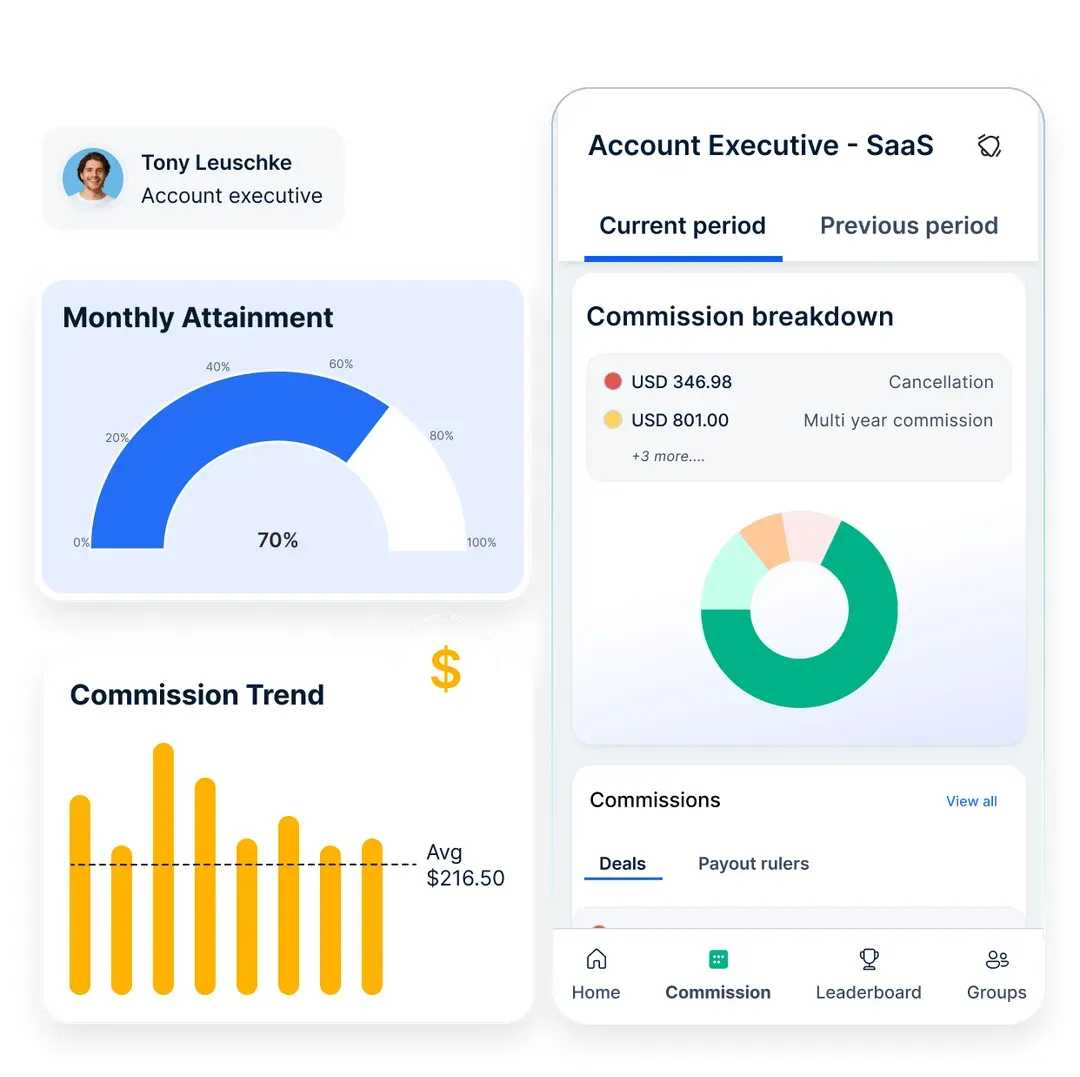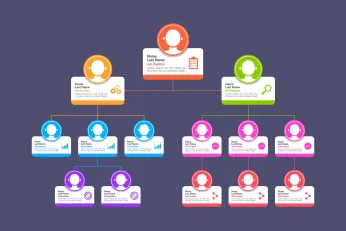OKR Jualan: Panduan untuk Menetapkan dan Mencapai Objektif Jualan dan Keputusan Utama
Kejayaan jualan bukan hanya tentang mencapai kuota—ia tentang menetapkan objektif yang betul dan menjejaki hasil yang boleh diukur. Dalam panduan ini, pelajari cara membuat OKR Jualan yang menyelaraskan matlamat pasukan anda dengan pertumbuhan perniagaan, memastikan tumpuan, akauntabiliti dan kemajuan berterusan.
Pada halaman ini
Menetapkan matlamat yang jelas dan boleh diukur adalah penting untuk memacu kejayaan jualan. Penyelidikan menunjukkan bahawa syarikat yang mempunyai matlamat yang jelas adalah 10 kali lebih berkemungkinan untuk mencapai hasil yang ketara berbanding syarikat yang tidak mempunyai matlamat berstruktur. Di sinilah OKR—Objektif dan Keputusan Utama—bermain.
Dengan menyediakan rangka kerja berstruktur untuk penetapan matlamat, OKR membantu pasukan jualan menyelaraskan usaha mereka dengan objektif perniagaan yang lebih luas, kekal fokus dan mengukur kemajuan mereka dengan berkesan. Malah, organisasi yang menggunakan OKR telah melaporkan peningkatan produktiviti sebanyak 21%. dan peningkatan sebanyak 32% dalam penglibatan pekerja.
Dalam blog ini, kami akan meneroka perkara penting OKR Jualan, cara menetapkan dan melaksanakannya serta berkongsi contoh praktikal untuk membantu anda bermula. Sama ada anda seorang pengurus jualan atau ahli pasukan, panduan ini akan melengkapkan anda dengan alatan untuk meningkatkan prestasi jualan anda melalui OKR yang direka dengan baik.
Memahami OKR jualan
OKR, yang bermaksud Objektif dan Keputusan Utama, ialah rangka kerja penetapan matlamat yang telah mendapat populariti kerana kesederhanaan dan keberkesanannya. Konsep ini berasal pada tahun 1970-an di Intel dan sejak itu telah diterima pakai oleh banyak syarikat terkemuka, termasuk Google, LinkedIn, dan Twitter.
Dalam jualan, OKR (Objektif dan Keputusan Utama) ialah rangka kerja strategik yang digunakan untuk menetapkan, berkomunikasi dan memantau matlamat dan hasil dalam pasukan jualan. Komponen utama OKR Jualan ialah:
- Objektif: Ini adalah matlamat kualitatif peringkat tinggi yang ingin dicapai oleh pasukan jualan. Objektif hendaklah bercita-cita tinggi, memberi inspirasi, dan ditakrifkan dengan jelas untuk memberikan hala tuju yang jelas untuk pasukan. Mereka menjawab soalan: "Apa yang kita mahu capai?"
- Keputusan Utama: Ini adalah hasil khusus dan boleh diukur yang membantu menjejaki kemajuan ke arah mencapai objektif. Keputusan utama harus boleh diukur dan terikat masa, menjawab soalan: "Bagaimanakah kita akan mengukur kejayaan dalam mencapai objektif?"
Kepentingan OKR jualan
OKR Jualan memainkan peranan penting dalam memastikan usaha pasukan jualan sejajar dengan matlamat strategik syarikat. Berikut ialah beberapa sebab utama mengapa OKR Jualan penting:
- Menyelaraskan matlamat jualan dengan objektif perniagaan: OKR Jualan memastikan matlamat pasukan jualan diselaraskan secara langsung dengan objektif perniagaan yang lebih luas. Penjajaran ini membantu dalam memacu strategi keseluruhan dan mencapai matlamat jangka panjang syarikat.
- Memacu fokus dan akauntabiliti: Dengan menetapkan OKR khusus dan boleh diukur, pasukan jualan boleh kekal fokus pada perkara yang paling penting. Tumpuan ini membantu dalam mengelakkan gangguan dan memastikan semua usaha diarahkan ke arah mencapai objektif yang ditetapkan. Selain itu, OKR menggalakkan akauntabiliti kerana setiap ahli pasukan memahami peranan mereka dalam mencapai matlamat.
- Meningkatkan prestasi dan motivasi: Objektif yang jelas dan mencabar mendorong pasukan jualan untuk melakukan yang terbaik. Ketelusan dan penjejakan tetap yang dikaitkan dengan OKR membantu dalam mengiktiraf pencapaian dan menangani isu dengan segera, sekali gus meningkatkan prestasi keseluruhan.
- Memudahkan penambahbaikan berterusan: OKR jualan menyediakan rangka kerja untuk penambahbaikan berterusan. Dengan kerap menyemak dan mengemas kini OKR, pasukan jualan boleh menyesuaikan diri dengan keadaan pasaran yang berubah-ubah, belajar daripada pengalaman mereka dan terus meningkatkan strategi dan prestasi mereka.
Jenis OKR jualan
OKR jualan boleh dikategorikan kepada beberapa jenis, setiap satu memfokuskan pada aspek proses jualan yang berbeza. Memahami jenis ini boleh membantu dalam menetapkan OKR yang lebih disasarkan dan berkesan. Berikut ialah beberapa jenis OKR Jualan yang biasa:
- OKR berasaskan hasil: OKR ini menumpukan pada peningkatan hasil jualan. Contohnya termasuk objektif yang berkaitan dengan pertumbuhan hasil keseluruhan, mencapai sasaran jualan tertentu atau meningkatkan saiz purata tawaran.
- OKR berasaskan pelanggan: Ini bertujuan untuk memperoleh dan mengekalkan pelanggan. Ia boleh termasuk objektif yang berkaitan dengan kepuasan pelanggan, pemerolehan pelanggan, kadar pengekalan atau mengembangkan pangkalan pelanggan.
- OKR berasaskan produk: OKR ini berkaitan dengan produk atau perkhidmatan tertentu. Objektif mungkin termasuk meningkatkan jualan produk tertentu, melancarkan produk baharu dengan jayanya atau menambah baik ciri produk berdasarkan maklum balas pelanggan.
- OKR berasaskan proses: Menyasarkan penambahbaikan dalam proses jualan dan kecekapan. Contohnya termasuk objektif yang berkaitan dengan mengurangkan panjang kitaran jualan, meningkatkan kadar penukaran petunjuk atau meningkatkan kecekapan corong jualan.
- OKR berasaskan pasukan: Matlamat ditetapkan untuk pasukan jualan individu atau wilayah. Ini boleh menumpukan pada prestasi pasukan, kerjasama, latihan dan pembangunan, atau mencapai sasaran serantau tertentu.
15 Contoh OKR jualan
Untuk membantu anda bermula, berikut ialah 15 contoh OKR Jualan dengan penerangan terperinci yang boleh anda sesuaikan dengan keperluan pasukan anda sendiri:
1. Objektif: Meningkatkan hasil jualan suku tahunan.
Fokus pada memacu hasil yang lebih tinggi dalam suku tersebut dengan meningkatkan prestasi jualan keseluruhan dan menutup lebih banyak tawaran. Ini melibatkan mengenal pasti peluang utama untuk pertumbuhan hasil, memanfaatkan strategi jualan untuk memaksimumkan saiz tawaran dan memastikan tindakan susulan yang konsisten terhadap petunjuk.
- Keputusan Utama 1: Mencapai hasil jualan $500,000.
- Keputusan Utama 2: Tutup 50 tawaran baharu.
- Keputusan Utama 3: Tingkatkan purata saiz tawaran sebanyak 10%.
2. Objektif: Meningkatkan pengekalan pelanggan.
Meningkatkan kesetiaan dan kepuasan pelanggan untuk mengurangkan churn dan meningkatkan nilai jangka panjang. Ini boleh dicapai dengan meningkatkan perkhidmatan pelanggan, menawarkan pengalaman yang diperibadikan, dan menangani sebarang isu dengan segera untuk memastikan pelanggan kekal berpuas hati dan setia.
- Keputusan Utama 1: Tingkatkan kadar pembaharuan pelanggan kepada 85%.
- Keputusan Utama 2: Kurangkan kadar churn sebanyak 5%.
- Keputusan Utama 3: Laksanakan program kesetiaan pelanggan dengan 100 peserta aktif.
3. Objektif: Meluaskan bahagian pasaran.
Tangkap sebahagian besar pasaran dengan memperoleh pelanggan baharu dan meningkatkan kehadiran di kawasan yang disasarkan. Ini mungkin melibatkan memasuki kawasan geografi baharu, menyasarkan segmen pelanggan tertentu dan melancarkan kempen pemasaran untuk meningkatkan kesedaran jenama.
- Keputusan Utama 1: Memperoleh 100 pelanggan baharu dalam pasaran sasaran.
- Keputusan Utama 2: Tingkatkan bahagian pasaran sebanyak 5%.
- Keputusan Utama 3: Menjalankan 10 kempen penembusan pasaran.
4. Objektif: Meningkatkan produktiviti pasukan jualan.
Tingkatkan kecekapan dan keberkesanan pasukan jualan melalui alat yang lebih baik, latihan dan proses yang diperkemas. Dengan mengurangkan masa yang dihabiskan untuk tugas pentadbiran dan meningkatkan teknik jualan, pasukan boleh memberi lebih tumpuan kepada penjualan dan penutupan tawaran.
- Keputusan Utama 1: Tingkatkan volum panggilan jualan sebanyak 20%.
- Keputusan Utama 2: Kurangkan panjang kitaran jualan sebanyak 15%.
- Keputusan Utama 3: Laksanakan sistem CRM baharu dengan kadar penggunaan 90%.
5. Objektif: Meningkatkan jualan produk.
Dorong jualan yang lebih tinggi untuk produk tertentu dengan menyasarkan segmen pelanggan utama dan mempromosikan manfaat produk. Ini boleh termasuk menjalankan kempen pemasaran yang disasarkan, menawarkan promosi dan mendidik pelanggan tentang nilai unik produk.
- Keputusan Utama 1: Tingkatkan jualan produk X sebanyak 25%.
- Keputusan Utama 2: Jalankan 5 webinar produk dengan 200 peserta setiap satu.
- Keputusan Utama 3: Mencapai kadar jualan naik 30% untuk produk X.
6. Objektif: Meningkatkan penjanaan petunjuk.
Menjana volum yang lebih tinggi petunjuk kualiti untuk menyalurkan saluran paip jualan dan memacu pertumbuhan masa hadapan. Ini melibatkan pelaksanaan strategi penjanaan petunjuk, mengoptimumkan usaha pemasaran dan memastikan petunjuk dipupuk dan ditukar dengan berkesan.
- Keputusan Utama 1: Hasilkan 1,000 petunjuk baharu.
- Keputusan Utama 2: Tingkatkan kadar penukaran petunjuk kepada 20%.
- Keputusan Utama 3: Laksanakan kempen pemupukan petunjuk automatik.
7. Objektif: Mengeratkan hubungan pelanggan.
Memupuk hubungan yang lebih mendalam dengan pelanggan untuk meningkatkan kepuasan, kesetiaan dan penglibatan jangka panjang. Membina hubungan yang kukuh melibatkan pemahaman keperluan pelanggan, menyediakan perkhidmatan yang luar biasa dan secara proaktif menangani sebarang isu.
- Keputusan Utama 1: Tingkatkan skor kepuasan pelanggan kepada 90%.
- Keputusan Utama 2: Jalankan 50 temu bual maklum balas pelanggan.
- Keputusan Utama 3: Selesaikan aduan pelanggan dalam masa 24 jam.
8. Objektif: Meningkatkan latihan dan pembangunan jualan.
Melabur dalam kemahiran dan pengetahuan pasukan jualan untuk meningkatkan prestasi dan keupayaan keseluruhan. Latihan dan pembangunan berterusan memastikan wakil jualan dilengkapi dengan teknik dan pengetahuan terkini untuk cemerlang dalam peranan mereka.
- Keputusan Utama 1: Menjalankan 10 sesi latihan jualan.
- Keputusan Utama 2: Mencapai 80% kadar pensijilan pasukan jualan.
- Keputusan Utama 3: Meningkatkan prestasi pasukan jualan sebanyak 15%.
9. Objektif: Meningkatkan peluang jualan silang dan jualan naik.
Kenal pasti dan manfaatkan peluang untuk menjual produk atau perkhidmatan tambahan kepada pelanggan sedia ada. Ini melibatkan pemahaman keperluan pelanggan, melatih pasukan jualan tentang teknik jualan silang dan penjualan tinggi, dan menyepadukan strategi ini ke dalam proses jualan.
- Keputusan Utama 1: Kenal pasti 50 peluang jualan silang.
- Keputusan Utama 2: Tingkatkan hasil upsell sebanyak 20%.
- Keputusan Utama 3: Latih pasukan jualan mengenai strategi jualan silang dan jualan naik.
10. Objektif: Mengoptimumkan proses jualan.
Memperkemas dan menambah baik proses jualan untuk meningkatkan kecekapan dan mengurangkan beban pentadbiran. Dengan melaksanakan alat automasi dan memperhalusi aliran kerja, pasukan jualan boleh memberi lebih tumpuan kepada aktiviti strategik yang memacu hasil.
- Keputusan Utama 1: Kurangkan tugas pentadbiran sebanyak 25%.
- Keputusan Utama 2: Laksanakan alat automasi jualan dengan kadar penggunaan 80%.
- Keputusan Utama 3: Tingkatkan kecekapan proses jualan sebanyak 30%.
11. Objektif: Berkembang ke wilayah baharu.
Kembangkan perniagaan dengan memasuki pasaran geografi baharu dan memperoleh pelanggan baharu di kawasan tersebut. Ini boleh melibatkan penyelidikan pasaran, membangunkan strategi khusus wilayah dan mewujudkan kehadiran tempatan untuk memberi perkhidmatan yang lebih baik kepada pelanggan baharu.
- Keputusan Utama 1: Masukkan 3 pasaran geografi baharu.
- Keputusan Utama 2: Perolehi 200 pelanggan baharu di wilayah baharu.
- Keputusan Utama 3: Mencapai $1 juta hasil jualan daripada wilayah baharu.
12. Objektif: Meningkatkan ketepatan ramalan jualan.
Tingkatkan ketepatan ramalan jualan untuk merancang dan memperuntukkan sumber dengan lebih baik. Ramalan yang tepat membantu dalam mengurus inventori, belanjawan dan menetapkan sasaran jualan yang realistik.
- Keputusan Utama 1: Mencapai ketepatan 90% dalam ramalan jualan.
- Keputusan Utama 2: Laksanakan alat ramalan jualan baharu.
- Keputusan Utama 3: Latih pasukan jualan tentang meramal amalan terbaik.
13. Objektif: Meningkatkan jualan digital.
Tingkatkan saluran jualan dalam talian untuk menangkap pasaran digital yang semakin berkembang dan menjangkau lebih ramai pelanggan. Ini melibatkan pengoptimuman platform jualan dalam talian, menjalankan kempen pemasaran digital dan meningkatkan pengalaman membeli-belah dalam talian pelanggan.
- Keputusan Utama 1: Tingkatkan hasil jualan dalam talian sebanyak 40%.
- Keputusan Utama 2: Tingkatkan kadar penukaran tapak web kepada 15%.
- Keputusan Utama 3: Lancarkan 3 kempen pemasaran digital.
14. Objektif: Meningkatkan kerjasama pasukan jualan.
Memupuk kerja berpasukan dan komunikasi yang lebih baik dalam pasukan jualan untuk memacu kejayaan kolektif. Kerjasama yang berkesan memastikan ahli pasukan berkongsi pengetahuan, menyokong satu sama lain, dan bekerjasama ke arah matlamat bersama.
- Keputusan Utama 1: Laksanakan alat kerjasama pasukan.
- Keputusan Utama 2: Mengendalikan mesyuarat pasukan mingguan dengan kehadiran 100%.
- Keputusan Utama 3: Tingkatkan kadar penyiapan projek antara pasukan sebanyak 20%.
15. Objektif: Meningkatkan kos perolehan pelanggan (CAC).
Kurangkan kos untuk mendapatkan pelanggan baharu sambil mengekalkan atau meningkatkan kadar pemerolehan. Ini melibatkan pengoptimuman perbelanjaan pemasaran, memanfaatkan strategi kos efektif, dan meningkatkan kecekapan keseluruhan proses pemerolehan pelanggan.
- Keputusan Utama 1: Kurangkan CAC sebanyak 10%.
- Keputusan Utama 2: Tingkatkan penyertaan program rujukan sebanyak 30%.
- Keputusan Utama 3: Laksanakan strategi penjanaan petunjuk kos efektif.
Melaksanakan OKR jualan
Melaksanakan OKR Jualan dengan berkesan melibatkan pendekatan berstruktur untuk memastikan penjajaran, penglibatan dan penambahbaikan berterusan. Berikut adalah langkah-langkah utama:
- Mewujudkan pelan OKR jualan: Membangunkan pelan komprehensif yang menggariskan objektif, keputusan utama, garis masa dan tanggungjawab. Pelan ini harus dimaklumkan dengan jelas kepada seluruh pasukan jualan.
- Melibatkan pasukan jualan: Libatkan pasukan jualan dalam proses penetapan OKR untuk memastikan pembelian dan komitmen. Galakkan ahli pasukan untuk menyumbangkan pandangan mereka dan selaraskan matlamat peribadi dengan objektif pasukan.
- Alat dan perisian: Gunakan alat dan perisian untuk menjejak dan mengurus OKR Jualan. Platform seperti perisian OKR, sistem CRM dan alatan pengurusan projek boleh membantu dalam memantau kemajuan dan memudahkan kerjasama.
- Latihan dan sokongan: Menyediakan latihan dan sokongan berterusan kepada pasukan jualan untuk memastikan mereka memahami cara menetapkan dan mencapai OKR. Ini termasuk latihan menggunakan alatan dan memahami rangka kerja OKR.
- Daftar masuk biasa: Jadualkan daftar masuk biasa untuk menyemak kemajuan, menangani cabaran dan membuat pelarasan yang diperlukan. Daftar masuk ini boleh dilakukan setiap minggu atau dua kali seminggu, bergantung pada keperluan pasukan dan kerumitan objektif.
- Maklum balas dan pengiktirafan: Galakkan maklum balas terbuka dan mengiktiraf pencapaian. Raikan pencapaian dan kejayaan untuk memastikan pasukan bermotivasi dan fokus pada matlamat mereka.
- Penambahbaikan berterusan: Gunakan cerapan yang diperoleh daripada proses OKR untuk menambah baik perancangan dan pelaksanaan masa hadapan. Laraskan strategi berdasarkan apa yang berkesan dan apa yang tidak berkesan untuk terus meningkatkan keberkesanan OKR Jualan anda.
Dengan mengikut langkah ini, anda boleh memastikan bahawa OKR Jualan anda dilaksanakan dengan berkesan, memacu penjajaran, penglibatan dan kejayaan merentas pasukan jualan.
Memantau dan menyemak OKR jualan
Memantau dan menyemak OKR Jualan secara berkala adalah penting untuk memastikan ia kekal relevan dan boleh dicapai. Proses ini melibatkan penjejakan kemajuan, membuat pelarasan mengikut keperluan, dan meraikan kejayaan untuk mengekalkan motivasi dan penjajaran.
- Daftar masuk biasa: Jadualkan daftar masuk yang kerap, seperti mesyuarat mingguan atau dwi-mingguan, untuk menyemak kemajuan pada OKR. Mesyuarat ini harus melibatkan pasukan jualan dan pemegang kepentingan utama untuk membincangkan pencapaian, cabaran dan langkah seterusnya.
- Menggunakan data dan metrik: Gunakan data dan metrik untuk menilai secara objektif kemajuan ke arah keputusan utama. Alat analitis jualan, sistem CRM dan mekanisme pelaporan lain boleh memberikan cerapan berharga tentang prestasi.
- Melaraskan OKR mengikut keperluan: Jadilah fleksibel dan bersedia untuk melaraskan OKR jika perlu. Keadaan pasaran, keutamaan perniagaan dan cabaran yang tidak dijangka boleh memerlukan pengubahsuaian untuk memastikan objektif kekal realistik dan boleh dicapai.
- Maklum balas dan kerjasama: Galakkan maklum balas dan kerjasama terbuka semasa semakan. Ahli pasukan harus berasa selesa berkongsi pandangan dan cadangan mereka untuk meningkatkan hasil OKR.
- Meraikan kejayaan: Mengiktiraf dan meraikan pencapaian dan pencapaian. Mengiktiraf kejayaan meningkatkan semangat dan mengukuhkan nilai menetapkan dan mencapai OKR.
- Penambahbaikan berterusan: Gunakan cerapan yang diperoleh daripada memantau dan menyemak OKR untuk memaklumkan proses penetapan matlamat masa hadapan. Belajar daripada perkara yang berkesan dan kenal pasti bidang untuk penambahbaikan untuk meningkatkan keberkesanan OKR Jualan anda dari semasa ke semasa.
Pemantauan dan semakan yang berkesan terhadap OKR Jualan memastikan bahawa pasukan jualan kekal di landasan yang betul, kekal bermotivasi dan terus meningkatkan prestasi mereka.
Kisah kejayaan syarikat yang telah melaksanakan OKR
Beberapa kisah kejayaan dalam OKR jualan adalah seperti berikut:
1. Google
Syarikat yang berjaya seperti Google telah menggunakan OKR sejak 1999, yang membantu mereka berkembang daripada 40 kepada 60,000 pekerja.
Google telah lama bergantung pada rangka kerja OKR kerana ia memberikan hasil yang luar biasa. Mereka menetapkan objektif yang bercita-cita tinggi dan menilai keputusan utama mereka pada skala 0 hingga 1.0 pada akhir setiap suku tahun.
Google amat percaya pada ketelusan OKR, membolehkan semua orang melihat perkara yang sedang diusahakan oleh orang lain. Mereka menganggap OKR menjaringkan antara 0.6 dan 0.7 sebagai berjaya, menunjukkan matlamat yang bercita-cita tinggi. Jika seseorang secara konsisten mendapat markah 1.0, ini menunjukkan matlamat mereka tidak cukup mencabar.
Google juga melihat OKR gred rendah sebagai berharga, menggunakannya sebagai data untuk memaklumkan OKR untuk suku seterusnya.
2. LinkedIn
LinkedIn juga menggunakan OKR, rangka kerja yang telah menyumbang dengan ketara kepada pertumbuhan pesatnya menjadi sebuah syarikat bernilai $20 bilion.
Ketua Pegawai Eksekutif LinkedIn, Jeff Weiner, menekankan kepentingan menyediakan hala tuju yang jelas kepada pemimpin perniagaan, kerana untuk mencapai hasil terbaik memerlukan visi dan misi yang jelas.
Menurut Weiner, pemimpin yang baik boleh meningkatkan seluruh pasukan melalui bimbingan, bimbingan strategik, menentukan objektif yang jelas, dan mengukur keputusan. Beliau percaya bahawa OKR harus bercita-cita tinggi dan terikat dengan masa, memotivasikan seluruh pasukan untuk menetapkan matlamat yang mencabar. Weiner mengesyorkan menetapkan 3 hingga 5 OKR setiap suku tahun.
Untuk menjejaki kemajuan OKR, Weiner mengadakan mesyuarat mingguan tiga jam dengan pekerja dan mesyuarat sehari penuh sekali sebulan. Mesyuarat ini direka untuk memastikan beliau sentiasa dikemas kini tentang cara pekerja bekerja ke arah objektif perniagaan. Semasa sesi ini, pekerja berkongsi pencapaian mereka dari minggu sebelumnya, membantu mereka kekal fokus dan meneruskan usaha produktif mereka di LinkedIn.
3. Huawei
Huawei , salah satu syarikat telekomunikasi terbesar di dunia, beralih daripada strategi KPI tradisional kepada OKR untuk meningkatkan kejayaan perniagaan mereka.
Huawei pada mulanya menggunakan sistem KPI untuk menjejak kejayaan perniagaan. Walau bagaimanapun, ia tidak begitu berkesan untuk mereka kerana sistem KPI memfokuskan pada penetapan matlamat sebagai titik permulaan dan penilaian prestasi sebagai titik akhir, tanpa memberikan pemahaman yang jelas tentang nilai matlamat tersebut kepada pekerja mereka.
Pada 2023, Huawei memutuskan untuk mengguna pakai OKR selepas menyedari bahawa banyak organisasi berjaya mencapai objektif mereka menggunakan metodologi ini. Dengan OKR, mereka dapat menetapkan matlamat yang boleh dicapai dalam jangka masa tertentu. Pendekatan ini telah meningkatkan prestasi perniagaan mereka dengan ketara dengan menjajarkan semua pekerja untuk bekerjasama ke arah matlamat perniagaan yang sama.
Menjejak OKR jualan dengan Compass : Cerapan masa nyata, gamifikasi & motivasi

Menetapkan OKR Jualan yang bercita-cita tinggi ialah satu perkara—menjaga pasukan anda sejajar, terlibat dan berusaha secara konsisten ke arah mereka adalah perkara lain. Tanpa keterlihatan dan motivasi masa nyata, OKR boleh bertukar menjadi kotak pilihan lain dan bukannya pemacu prestasi sebenar.
Di situlah Compass mengubah permainan. Dengan menyepadukan penjejakan, gamifikasi dan insentif automatik dikuasakan AI, Compass memastikan bahawa OKR Jualan menjadi sebahagian daripada budaya jualan anda yang hidup dan bernafas.
Jadikan OKR sebagai enjin motivasi

Pasukan jualan menunjukkan prestasi terbaik apabila mereka mempunyai keterlihatan yang jelas tentang matlamat mereka dan laluan berstruktur untuk kejayaan. Compass menyediakan:
✅ Papan pemuka prestasi langsung : Beri wakil pandangan masa nyata tentang kemajuan mereka ke arah OKR, memastikan ketelusan, akauntabiliti dan motivasi berterusan.✅ Matlamat & pertandingan jualan yang menarik : Jadikan OKR menarik dengan papan pendahulu, cabaran bertemakan perlumbaan dan pertandingan berpasukan yang mengubah sasaran menjadi persaingan mesra.✅ dengan pengiktirafan serta-merta & insentif kemenangan, pengiktirafan serta insentif kemenangan : Ganjaran Kemajuan OKR, memastikan wakil terlibat.✅ Bimbingan & cerapan berasaskan data : Jejaki arah aliran jualan, lihat kawasan untuk penambahbaikan dan laraskan sasaran secara dinamik untuk memastikan prestasi berada di landasan yang betul.
Wujudkan budaya pencapaian
Dengan Compass , OKR Jualan menjadi lebih daripada sekadar sasaran—ia menjadi batu loncatan kepada prestasi tinggi. Daripada menunggu laporan akhir suku tahun, wakil dan pengurus mendapat maklum balas masa nyata, yang membolehkan pembetulan kursus serta peningkatan motivasi serta-merta.
Pasukan yang bermotivasi dan dipacu matlamat bukan sekadar mencapai OKR—mereka melebihi mereka. Bersedia untuk menjadikan OKR Jualan anda sebagai kuasa yang berkuasa untuk berjaya? Compass menjadikannya berlaku. 🚀
Cara jenama minuman mengubah prestasi jualan dengan Compass
Jenama chai dan kopi omnichannel , memberi perkhidmatan kepada berjuta-juta pelanggan setiap hari merentasi pelbagai titik sentuh seperti kedai runcit, dapur awan dan pejabat korporat.
Dengan pasukan pembangunan perniagaan yang besar dan rangkaian pengedaran yang tersebar di 43 bandar utama, pengurusan prestasi jualan dan program insentif menjadi semakin kompleks dan tidak cekap.
Proses manual menjejak prestasi jualan dan mengira komisen menyebabkan kelewatan dalam pembayaran dan kekurangan ketelusan untuk pasukan jualan.
Cabarannya: Program insentif Chaipoint untuk peruncit dan pengedar sangat bergantung pada penjejakan manual data penggunaan, penggunaan mesin dan pembolehubah lain seperti deposit keselamatan dan caj penyelenggaraan. Tanpa sistem berpusat, pasukan jualan tidak dapat melihat prestasi mereka, dan kelewatan dalam pembayaran komisen adalah perkara biasa disebabkan oleh pelbagai faktor dan penglibatan pasukan.
Penyelesaian: Chaipoint dilaksanakan Compass penyelesaian pengurusan prestasi jualan untuk menangani cabaran ini:
- Keterlihatan dipertingkat: Pasukan jualan dan pengedar diberi akses masa nyata kepada prestasi, sasaran dan pengiraan insentif mereka, meningkatkan ketelusan dan penglibatan.
- Pengiraan komisen diperkemas: Pembolehubah kompleks dalam program insentif dipermudahkan, menjadikan pengiraan komisen lebih telus dan mudah difahami.
- Proses automatik: Compass mengautomasikan keseluruhan proses penjejakan prestasi jualan, menghapuskan kelewatan dalam pengeluaran pembayaran dan menyediakan data masa nyata untuk membuat keputusan yang lebih baik.
Keputusan:
- Peningkatan 200% dalam pembayaran insentif dalam masa kurang daripada enam bulan.
- Pertumbuhan 115% dalam kelayakan insentif dalam enam bulan.
- Peningkatan 4% dalam hasil penggunaan suku ke suku.
- Peningkatan 40% dalam penggunaan mesin dalam tempoh enam bulan.
Dengan melaksanakan Compass , Chaipoint dapat mencipta sistem pengurusan prestasi jualan yang cekap dan telus yang memotivasikan pasukan mereka dan memacu peningkatan ketara dalam hasil jualan.
Ingin memudahkan pengurusan prestasi jualan anda? Temui caranya Compass boleh membantu anda membina program komisen jualan yang telus dan cekap untuk memacu pertumbuhan.
Kesimpulan
OKR Jualan ialah alat yang berkuasa untuk menetapkan matlamat yang jelas dan boleh diukur yang memacu prestasi jualan dan menyelaraskan usaha pasukan dengan objektif perniagaan yang lebih luas. Dengan memahami asas OKR, kepentingan menyelaraskannya dengan matlamat perniagaan, dan pelbagai jenis OKR Jualan, anda boleh melaksanakan rangka kerja ini dengan berkesan dalam pasukan jualan anda.
Ingat untuk menetapkan objektif SMART dan hasil utama yang boleh diukur, libatkan pasukan jualan anda dalam proses dan sentiasa memantau dan menyemak kemajuan. Dengan menangani cabaran biasa dan belajar daripada contoh kehidupan sebenar, anda boleh mengatasi halangan dan memacu peningkatan berterusan.
Menggabungkan OKR Jualan ke dalam strategi penetapan matlamat anda bukan sahaja meningkatkan fokus dan akauntabiliti tetapi juga meningkatkan produktiviti dan motivasi. Mula menetapkan dan melaksanakan OKR Jualan hari ini untuk membuka potensi penuh pasukan anda dan mencapai kejayaan jualan yang cemerlang.
Soalan lazim
1. Apakah OKR Jualan?
OKR Jualan (Objektif dan Keputusan Utama) ialah rangka kerja penetapan matlamat yang direka untuk membantu pasukan jualan menetapkan objektif yang jelas, boleh diukur dan menjejaki kemajuan mereka ke arah mencapainya. Objektifnya adalah bercita-cita tinggi dan kualitatif, manakala keputusan utama adalah khusus dan boleh diukur.
2. Bagaimanakah OKR Jualan berbeza daripada kaedah penetapan matlamat yang lain?
OKR Jualan berbeza daripada kaedah penetapan matlamat lain dengan penekanan mereka pada hasil yang boleh diukur dan penjajaran dengan matlamat perniagaan yang lebih luas. Mereka menumpukan pada menetapkan objektif yang bercita-cita tinggi lagi boleh dicapai dan menjejaki keputusan yang spesifik dan boleh diukur untuk mengukur kemajuan. Kaedah ini menggalakkan ketelusan, akauntabiliti dan peningkatan berterusan.
3. Berapa kerapkah OKR Jualan perlu disemak?
OKR jualan harus disemak secara berkala, biasanya setiap minggu atau dwi-mingguan. Daftar masuk yang kerap membolehkan pasukan menjejak kemajuan, menangani cabaran dan membuat pelarasan yang diperlukan untuk terus berada di landasan.
4. Apakah alatan terbaik untuk menguruskan OKR Jualan?
Terdapat beberapa alatan yang tersedia untuk mengurus OKR Jualan, termasuk perisian OKR seperti Workfront, Gtmhub dan Ally.io. Selain itu, sistem CRM seperti Salesforce, HubSpot dan alatan pengurusan projek seperti Asana dan Trello boleh membantu dalam menjejak kemajuan dan memudahkan kerjasama.
5. Bolehkah OKR Jualan dilaraskan pertengahan kitaran?
Ya, OKR Jualan boleh dilaraskan pertengahan kitaran jika perlu. Fleksibiliti adalah penting untuk menyesuaikan diri dengan perubahan keadaan pasaran, keutamaan perniagaan atau cabaran yang tidak dijangka. Semakan tetap membantu mengenal pasti bila pelarasan diperlukan untuk memastikan objektif kekal realistik dan boleh dicapai.
6. Bagaimanakah anda memastikan pembelian masuk pasukan untuk OKR Jualan?
Memastikan pembelian masuk pasukan untuk OKR Jualan melibatkan penglibatan pasukan jualan dalam proses penetapan OKR, menyampaikan manfaat dengan jelas dan menyediakan latihan yang komprehensif. Melibatkan ahli pasukan dalam mewujudkan OKR meningkatkan pemilikan dan komitmen. Mengiktiraf dan memberi ganjaran kepada pencapaian juga memupuk sikap positif terhadap OKR.
7. Apakah kekerapan menetapkan OKR Jualan?
OKR jualan biasanya ditetapkan pada setiap suku tahun. Jangka masa ini cukup panjang untuk mencapai hasil yang ketara tetapi cukup singkat untuk kekal fleksibel dan responsif kepada perubahan. Walau bagaimanapun, sesetengah organisasi juga boleh menetapkan OKR tahunan untuk matlamat jangka panjang, dengan OKR suku tahunan bertindak sebagai batu loncatan.
8. Bagaimanakah OKR Jualan menyumbang kepada pertumbuhan perniagaan secara keseluruhan?
OKR jualan menyumbang kepada pertumbuhan perniagaan keseluruhan dengan menyelaraskan usaha jualan dengan objektif strategik syarikat. Penjajaran ini memastikan bahawa aktiviti jualan secara langsung menyokong matlamat perniagaan, memacu pertumbuhan hasil, pengembangan pasaran dan meningkatkan kepuasan pelanggan. Selain itu, tumpuan pada hasil yang boleh diukur meningkatkan akauntabiliti dan prestasi.
9. Apakah peranan kepimpinan dalam kejayaan OKR Jualan?
Kepimpinan memainkan peranan penting dalam kejayaan OKR Jualan dengan menyediakan hala tuju, sokongan dan sumber. Pemimpin mesti terlibat secara aktif dalam proses OKR, menyampaikan kepentingan OKR kepada pasukan, dan memupuk budaya ketelusan dan akauntabiliti. Komitmen dan penglibatan mereka adalah penting dalam memotivasikan pasukan jualan dan memastikan pelaksanaan OKR yang berkesan.













